Dairy Waste and Potential of Small-Scale Biogas Digester for Rural Energy in India
Abstract
1. Introduction
2. Livestock Population and Manure Production in India
3. Utilization of Livestock Waste and Renewable Energy Consumption Pattern in Rural India
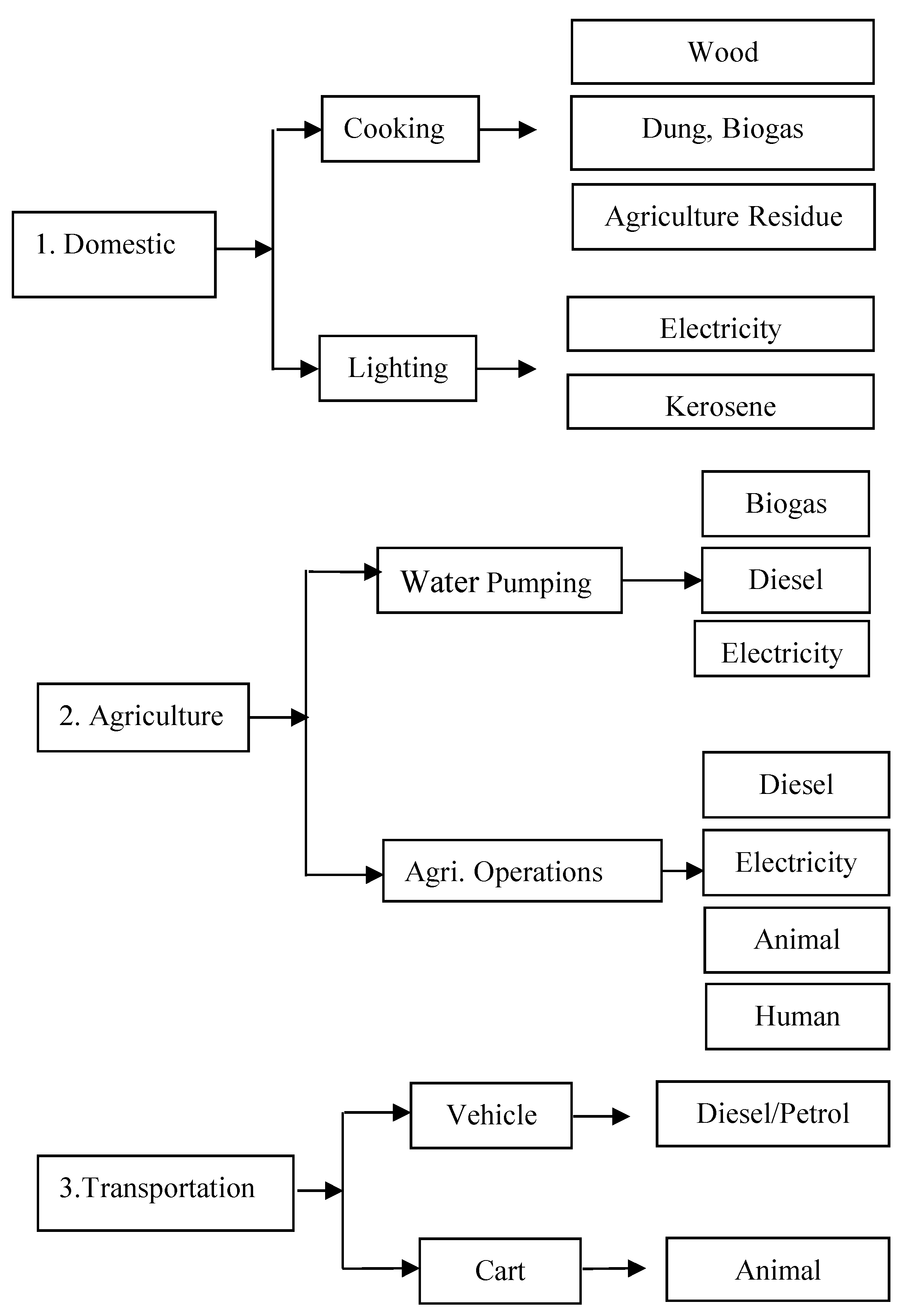
| Livestock Type | Production of Manure (Million Tonnes/Year) | Waste Use as a Source of Cooking Energy | Waste Use as a Source of Fertilizer | Waste Use for Biogas Production Using Biogas Digester | Source |
|---|---|---|---|---|---|
| Cow | 730 | Yes | Yes | Yes | [51] |
| Buffalo | 574 | Yes | Yes | Yes | [51] |
| Chicken | 6.25–8 | No | Yes | Yes | [52] |
| Sheep | 3.28 | No | Yes | Yes | [53] |
| Goat | 93.06 | No | Yes | Yes | [54] |
4. Biogas Promotion and Various Biogas Model Types Population in India
5. Limitation in Biogas Production and Future Biogas Potential in India
6. Future Perspective for Biogas Technology in India
7. Conclusions
Author Contributions
Funding
Institutional Review Board Statement
Informed Consent Statement
Data Availability Statement
Acknowledgments
Conflicts of Interest
References
- Garg, P. Energy scenario and vision 2020 in India. J. Sustain. Energy Environ. 2012, 3, 7–17. [Google Scholar]
- Countries of the World by Population. 2021. Available online: https://www.nationsonline.org/oneworld/population-by-country.htm (accessed on 7 September 2021).
- BBC. What Has Brought India’s Farmers to the Streets? Available online: https://www.bbc.com/news/world-asia-india-55157574 (accessed on 7 September 2021).
- Census Report 2011, Government of India. Available online: https://censusindia.gov.in/ (accessed on 7 September 2021).
- BBC. India Farmer Protests: How Rural Incomes Have Struggled to Keep Up. Available online: https://www.bbc.com/news/world-asia-india-55413499 (accessed on 7 September 2021).
- PRB. How People in India ‘Really Live’. Available online: https://www.prb.org/resources/how-people-in-india-really-live/ (accessed on 7 September 2021).
- United Nations University Research Brief. Inequality in Rural India. Available online: https://www.wider.unu.edu/publication/inequality-rural-india (accessed on 7 September 2021).
- Pew Research Center. World Population by Income. Available online: https://www.pewresearch.org/global/interactives/global-population-by-income/ (accessed on 7 September 2021).
- FAO. Gateway to Dairy Production and Products. Available online: http://www.fao.org/dairy-production-products/production/en/ (accessed on 7 September 2021).
- Economic Survey: Milk Production Rises by Five Percent to 198.4 Million Tonnes in 2019–2020. Available online: https://economictimes.indiatimes.com/news/economy/agriculture/economic-survey-milk-production-rises-by-five-percent-to-198-4-million-tonnes-in-2019-20/articleshow/80585416.cms?from=mdr (accessed on 7 September 2021).
- Business World. Dairy Products in India: Where Does India Stand? 2021. Available online: http://www.businessworld.in/article/Dairy-Products-In-India-Where-Does-India-Stand-/05-01-2021-361921/ (accessed on 7 September 2021).
- FAO. India: Increasing Demand Challenges the Dairy Sector. 2021. Available online: http://www.fao.org/3/i0588e/I0588E05.htm (accessed on 7 September 2021).
- FAO. Livestock and the Environment. 2021. Available online: http://www.fao.org/livestock-environment/en/ (accessed on 7 September 2021).
- WHO. As More Go Hungry and Malnutrition Persists, Achieving Zero Hunger by 2030 in Doubt, UN Report Warns. Available online: https://www.who.int/news/item/13-07-2020-as-more-go-hungry-and-malnutrition-persists-achieving-zero-hunger-by-2030-in-doubt-un-report-warns (accessed on 7 September 2021).
- FAO. Hunger and Food Insecurity. 2021. Available online: http://www.fao.org/hunger/en/ (accessed on 7 September 2021).
- FAO. Manure Helps Feed the World. Integrated Manure Management Demonstrates Manure Is A Valuable Resource. Available online: http://www.fao.org/3/bl516e/bl516e.pdf (accessed on 9 September 2021).
- Bloomfield, E. Gender and Livelihoods Impacts of Clean Cookstoves in South Asia; Global Alliance for Clean Cookstoves: Washington, DC, USA, 2015; Available online: https://www.cleancookingalliance.org/binary-data/RESOURCE/file/000/000/363-1.pdf (accessed on 2 September 2021).
- Munandar, F.G.; Hayati, Y.R.; Munawar, A.I. Crop-Cattle Integrated Farming System: An Alternative of Climatic Change Mitigation. J. Anim. Sci. Technol. 2015, 38, 95–103. [Google Scholar] [CrossRef][Green Version]
- Pandey, P.K.; Ndegwa, P.M.; Alldredge, J.R.; Pitts, M.; Soupir, M.L. Modeling effects of granules on the start-up of anaerobic digestion of dairy wastewater with Langmuir and extended Freundlich equations. Bioprocess Biosyst. Eng. 2010, 33, 833–845. [Google Scholar] [CrossRef]
- Pandey, P.K.; Soupir, M.L. Escherichia coli inactivation kinetics in anaerobic digestion of dairy manure under moderate, mesophilic and thermophilic temperatures. AMB Express 2011, 1, 18. [Google Scholar] [CrossRef] [PubMed]
- Pandey, P.K.; Ndegwa, P.M.; Soupir, M.L.; Alldredge, R.J.; Pitts, M.J. Efficacies of inocula on the startup of anaerobic reactors treating dairy manure under stirred and unstirred conditions. Biomass Bioenergy 2011, 35, 2705–2720. [Google Scholar] [CrossRef]
- Angelidaki, I.; Ellegaard, L. Codigestion of manure and organic wastes in centralized biogas plants. Appl. Biochem. Biotechnol. 2003, 109, 95–105. [Google Scholar] [CrossRef]
- Aggarangsi, P.; Tippayawong, N.; Moran, J.C.; Rerkkriangkrai, P. Overview of livestock biogas technology development and implementation in Thailand. Energy Sustain. Dev. 2013, 17, 371–377. [Google Scholar] [CrossRef]
- Noorollahi, Y.; Kheirrouz, M.; Asl, H.F.; Yousefi, H.; Hajinezhad, A. Biogas production potential from livestock manure in Iran. Renew. Sustain. Energy Rev. 2015, 50, 748–754. [Google Scholar] [CrossRef]
- Chowdhury, T.; Chowdhury, H.; Hossain, N.; Ahmed, A.; Hossen, M.S.; Chowdhury, P.; Thirugnanasambandam, M.; Saidur, R. Latest advancements on livestock waste management and biogas production: Bangladesh’s perspective. J. Clean. Prod. 2012, 272, 122818. [Google Scholar] [CrossRef]
- Eghball, B.; Wienhold, B.J.; Gilley, J.E.; Eigenberg, R.A. Mineralization of manure nutrients. J. Soil Water Conserv. 2002, 57, 470–473. [Google Scholar]
- Ferguson, R.B.; Nienaber, J.A.; Eigenberg, R.A.; Woodbury, B.L. Long-term effects of sustained beef feedlot manure application on soil nutrients, corn silage yield, and nutrient uptake. J. Environ. Qual. 2005, 34, 1672–1681. [Google Scholar] [CrossRef]
- Pedaprolu, R.; Panwar, N.R.; Singh, A.R.; Ramana, S.; Rao, A.S. Impact of organic-manure combinations on the productivity and soil quality in different cropping systems in central India. J. Plant Nutr. Soil Sci. 2009, 172, 577–585. [Google Scholar]
- Hati, K.M.; Mandal, K.G.; Misra, A.K.; Ghosh, P.K.; Bandyopadhyay, K.K. Effect of inorganic fertilizer and farmyard manure on soil physical properties, root distribution, and water-use efficiency of soybean in Vertisols of central India. Bioresour. Technol. 2006, 97, 2182–2188. [Google Scholar] [CrossRef] [PubMed]
- Parham, J.; Deng, S.; Raun, W.; Johnson, G. Long-term cattle manure application in soil. Biol. Fertil. Soils 2002, 35, 328–337. [Google Scholar]
- El-Akabawy, M.A. Effect of some biofertilizers and farmyard manure on yield and nutrient uptake of Egyptian clover grown on loamy sand soil. Egypt. J. Agric. Res. 2000, 78, 1811–1820. [Google Scholar]
- Rasoulzadeh, A.; Yaghoubi, A. Effect of cattle manure on soil physical properties on a sandy clay loam soil in North-West Iran. J. Food Agric. Environ. 2010, 8, 976–979. [Google Scholar]
- Feroze, S.M.; Raju, V.T.; Singh, R.; Tripathi, A.K. Status of livestock sector: A micro study of North Eastern India. Indian J. Hill Farming 2010, 23, 43–51. [Google Scholar]
- Sonavale, K.P.; Shaikh, M.R.; Kadam, M.M.; Pokharkar, V.G. Livestock sector in India: A critical analysis. Asian J. Agric. Ext. Econ. Sociol. 2020, 38, 51–62. [Google Scholar] [CrossRef]
- Thiruvenkadan, A.K.; Rajendran, R.; Muralidharan, J. Buffalo genetic resources of India and their conservation. Buffalo Bull 2013, 32, 227–235. [Google Scholar]
- National Dairy Development Board. Livestock Population in India by Species. 2021. Available online: https://www.nddb.coop/information/stats/pop (accessed on 6 September 2021).
- Kaur, G.; Brar, Y.S.; Kothari, D.P. Potential of livestock generated biomass: Untapped energy source in India. Energies 2017, 10, 847. [Google Scholar] [CrossRef]
- Khaiwal, R.; Maninder, K.S.; Suman, M.; Siby, J. Trend in household energy consumption pattern in India: A case study on the influence of socio-cultural factors for the choice of clean fuel use. J. Clean. Prod. 2019, 213, 1024–1034. [Google Scholar]
- Murphy, J.D.; McKeogh, E. Technical, economic and environmental analysis of energy production from municipal solid waste. Renew. Energy 2004, 29, 1043–1057. [Google Scholar] [CrossRef]
- Qie, S.; Hailong, L.; Jinying, Y.; Longcheng, L.; Zhixin, Y.; Xinhai, Y. Selection of appropriate biogas upgrading technology-a review of biogas cleaning, upgrading and utilisation. Renew. Sustain. Energy Rev. 2015, 51, 521–532. [Google Scholar]
- Mittal, S.; Ahlgren, E.O.; Shukla, P.R. Barriers to biogas dissemination in India: A review. Energy Policy 2018, 112, 361–370. [Google Scholar] [CrossRef]
- Vijay, V.K.; Kapoor, R.; Trivedi, A.; Vijay, V. Biogas as clean fuel for cooking and transportation needs in India. In Advances in Bioprocess Technology; Springer International Publishing: Cham, Switzerland, 2015; pp. 257–275. [Google Scholar]
- Jha, B.; Kapoor, R.; Vijay, V.; Vijay, V.K.; Chandra, R. Biogas: A sustainable and potential fuel for transport application. J. Biofuels Bioenergy 2015, 1, 28–33. [Google Scholar] [CrossRef]
- Kapdi, S.S.; Vijay, V.K.; Rajesh, S.K.; Prasad, R. Biogas scrubbing, compression and storage: Perspective and prospectus in Indian context. Renew. Energy 2005, 30, 1195–1202. [Google Scholar] [CrossRef]
- Sinha, C.S.; Sinha, S.; Joshi, V. Energy use in the rural areas of India: Setting up a rural energy data base. Biomass Bioenergy 1998, 14, 489–503. [Google Scholar] [CrossRef]
- Kowsari, R.; Zerriffi, H. Three dimensional energy profile: A conceptual framework for assessing household energy use. Energy Policy 2011, 39, 7505–7517. [Google Scholar] [CrossRef]
- Rockefeller Foundation. Rural Electrification in India: Customer Behaviour and Demand. 2021. Available online: https://www.rockefellerfoundation.org/report/rural-electrification-india-customer-behaviour-demand/ (accessed on 1 September 2021).
- Choudhuri, P.; Desai, S. Gender inequalities and household fuel choice in India. J. Clean. Prod. 2020, 265, 121487. [Google Scholar] [CrossRef]
- ICRISAT. Smart Villages. Energy and Agriculture for Smart Villages in India. 2016. Available online: https://e4sv.org/wp-content/uploads/2017/01/Energy-and-Agriculture-for-Smart-Villages-in-India.compressed.pdf (accessed on 9 May 2021).
- Bhatia, R. Diffusion of renewable energy technologies in developing countries: A case study of biogas engines in India. World Dev. 1990, 18, 575–590. [Google Scholar] [CrossRef]
- Department of Animal Husbandry and Dairying. Government of India Report. Available online: https://dahd.nic.in/related-links/chapter-v-part-2 (accessed on 7 September 2021).
- Using Chicken Manure Fertilizer in Your Garden. Available online: https://www.gardeningknowhow.com/composting/manures/chicken-manure-fertilizer.htm (accessed on 7 September 2021).
- A Guide to Compost Sheep Manure for Organic Fertilizer. Available online: https://organicfertilizermachine.com/eco-solutions/compost-sheep-manure-organic-fertilizer.html (accessed on 6 September 2021).
- Agri Farming. Goat Manure Advantages and Disadvantages. Available online: https://www.agrifarming.in/goat-manure-advantages-and-disadvantages (accessed on 5 September 2021).
- Tomar, S.S. Status of biogas plant in India. Renew. Energy 1994, 5, 829–831. [Google Scholar] [CrossRef]
- Khan, E.U.; Martin, A.R. Review of biogas digester technology in rural Bangladesh. Renew. Sustain. Energy Rev. 2016, 62, 247–259. [Google Scholar] [CrossRef]
- Zia, S.; Sreekrishnan, T.R. Biogas: An evolutionary perspective in the Indian context. In Green Fuels Technology; Springer International Publishing: Cham, Switzerland, 2016; pp. 431–443. [Google Scholar]
- Azeem Hafiz, P.A.; Rashid, A.R.; Muhamed, S.A.; Sharukh, M. Study of Biogas as a Sustainable Energy Source in India. Int. J. Res. Mech. Eng. 2016, 4, 58–62. [Google Scholar]
- Statista. Number of Biogas Plants across India, as of March 2020, by State. 2020. Available online: https://www.statista.com/statistics/941298/india-number-of-biogas-plants-by-state/ (accessed on 7 September 2021).
- Livestock Census. Available online: https://vikaspedia.in/agriculture/agri-directory/reports-and-policy-briefs/20th-livestock-census (accessed on 2 September 2021).
- Bharti, V. India’s Programmes and Incentives Being Implemented to Support Biogas Systems; Ministry of New and Renewable Energy, Government of India: New Delhi, India, 2019. Available online: https://globalmethane.org/documents/01_India%27s%20programmes%20and%20incentives%20being%20implemented%20to%20support%20biogas%20systems_Vijay%20Barthi_MNRE.pdf (accessed on 25 September 2021).
- Narale, P.D.; Kharpude, S.N.; Seveda, M.S. Biogas Production, Utilization and Entrepreneurship Opportunities. In Bioenergy Engineering, 1st ed.; CRC Press: London, UK, 2021; pp. 17–34. [Google Scholar]
- MNRE. Ministry of New and Renewable Energy: Methane Reduction Policies. 2021. Available online: https://www.globalmethane.org/challenge/mnre.html#:~:text=The%20New%20National%20Biogas%20and%20Organic%20Manure%20Programme,1%20to%2025%20%20m%203%20per%20day (accessed on 25 September 2021).
- Mittal, S.; Ahlgren, E.O.; Shukla, P.R. Future biogas resource potential in India: A bottom-up analysis. Renew. Energy 2019, 141, 379–389. [Google Scholar] [CrossRef]
- Bioenergy Insight. India to Build 5000 Biogas Plants by 2023. 2018. Available online: https://www.bioenergy-news.com/news/india-to-build-5000-biogas-plants-by-2023/ (accessed on 18 September 2021).
- OkCredit. What Is the Future of the Biogas Industry in India? 2021. Available online: https://okcredit.in/blog/the-future-of-biogas-industry-in-india/ (accessed on 18 September 2021).
- Market Trends. Dairy Farms in India Become Bigger. 2017. Available online: https://www.dairyglobal.net/Market-trends/Articles/2017/12/Dairy-farms-in-India-become-bigger-226874E/ (accessed on 18 September 2021).
- FAO. Global Dairy Sector: Status and Trends. 2021. Available online: http://www.fao.org/3/i1522e/i1522e02.pdf (accessed on 18 September 2021).
- Quartz. India’s 75 Million Dairy Farms Now Produce More Milk than All of the European Union. 2014. Available online: https://qz.com/235085/india-75-million-dairy-farms-now-make-more-milk-than-all-of-the-european-union/ (accessed on 18 September 2021).
- The Vegan Review. Inside India’s World-Leading Dairy Industry. 2020. Available online: https://theveganreview.com/inside-indias-world-leading-dairy-industry/ (accessed on 18 September 2021).
- Parihar, S.S.; Saini, K.P.S.; Lakhani, G.P.; Jain, A.; Roy, B.; Ghosh, S.; Aharwal, B. Livestock waste management: A review. J. Entomol. Zool. Stud. 2019, 7, 384–393. [Google Scholar]
- Pandey, P.K.; Kass, P.H.; Soupir, M.L. Contamination of water resources by pathogenic bacteria. AMB Express 2014, 4, 51. [Google Scholar] [CrossRef] [PubMed]
- Pandey, P.K.; Biswas, S.; Vaddella, V.K.; Soupir, M.L. Escherichia coli persistence kinetics in dairy manure at moderate, mesophilic, and thermophilic temperatures under aerobic and anaerobic environments. Bioprocess Biosyst. Eng. 2015, 38, 457–467. [Google Scholar] [CrossRef]
- Pandey, P.K.; Soupir, M.L. Assessing the impacts of E. coli laden streambed sediment on E. coli loads over a range of flows and sediment characteristics. J. Am. Water Resour. Assoc. 2013, 49, 1261–1269. [Google Scholar] [CrossRef]
- Pandey, P.K.; Soupir, M.L. Impacts of temperatures on biogas production in dairy manure anaerobic digestion. International Journal of Engineering and Technology. Int. J. Eng. Technol. 2012, 4, 629. [Google Scholar] [CrossRef]
- Siya, A.W.; Yasin, M.; Ali, I.; Hussain, Z.; Asiam, M.; Khan, M. Performance evaluation of fixed dome and floating type biogas digesters for tubewell operation with dual fuel approach in Pakistan. Int. J. Innov. Appl. Stud. 2015, 10, 1225–1232. [Google Scholar]
- Javier, D.; Helbig, F.; Pfisterer, A.N. Humanitarian Energy Decarbonisation Webinar Series—Technical Trainings and Tools for Energy System Design. 2021. Available online: https://energypedia.info/wiki/Costs_of_a_Biogas_Plant#Production_Costs (accessed on 16 October 2021).
- Krich, K.; Augenstein, D.; Batmale, J.P.; Benemann, J.; Rutledge, B.; Salour, D. Biomethane from Dairy Waste. 2005. Available online: https://suscon.org/pdfs/cowpower/biomethaneSourcebook/Full_Report.pdf (accessed on 10 October 2021).
- Aui, A.; Wright, M.M. Life Cycle Cost Analysis of the Operations of Anaerobic Digesters in Iowa. 2018. Available online: http://www.iowabiogasmodel.us/Anaerobic_Digestion_LCA_Final_Report.pdf (accessed on 16 October 2021).
- Samar, K.K.; Sharma, D.; Meena, E. The Solid State Biogas Plant: A Boon for Water Scarce Areas Akshay Urja Ministry of New and Renewable Energy; Government of India: New Delhi, India, 2016.
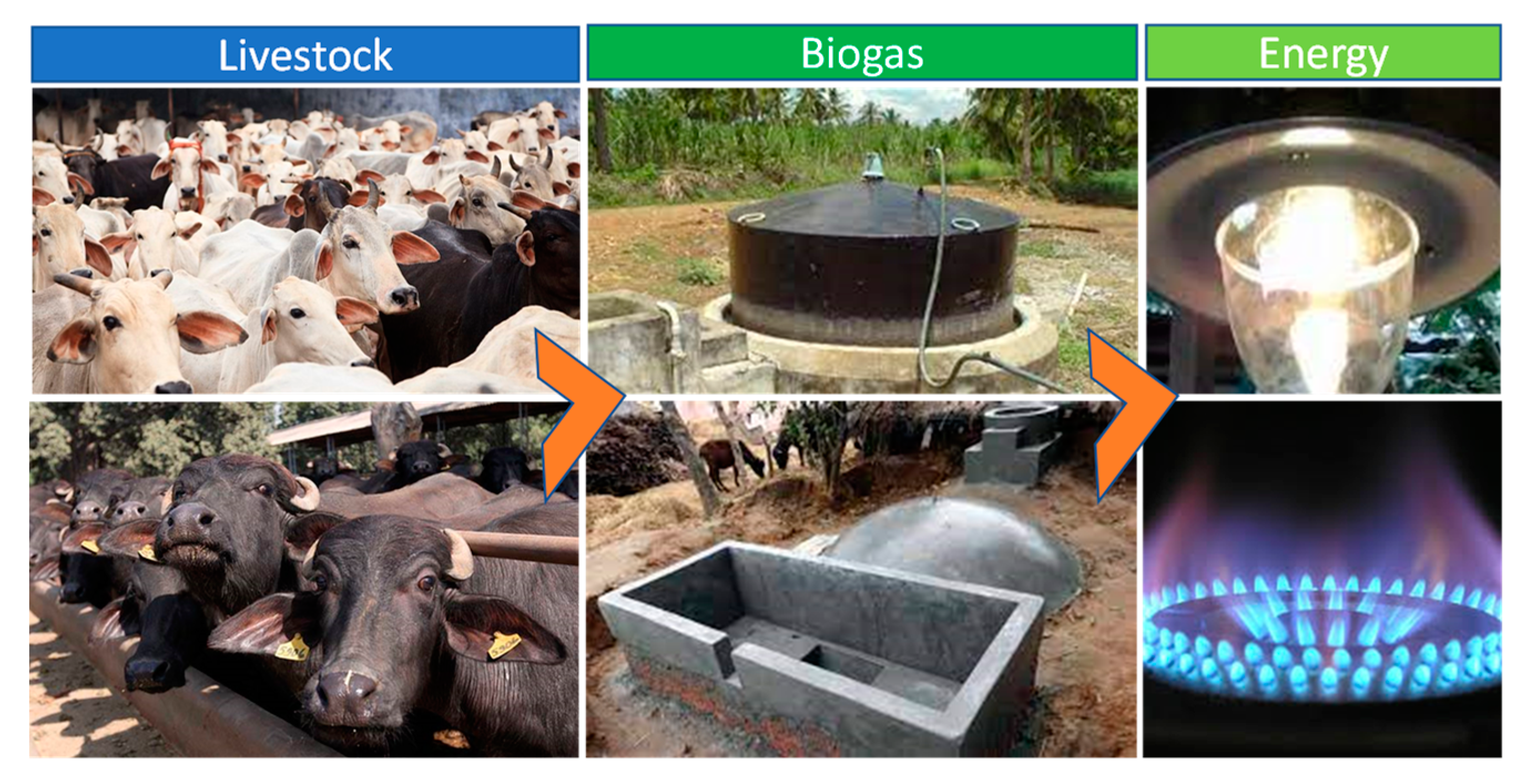
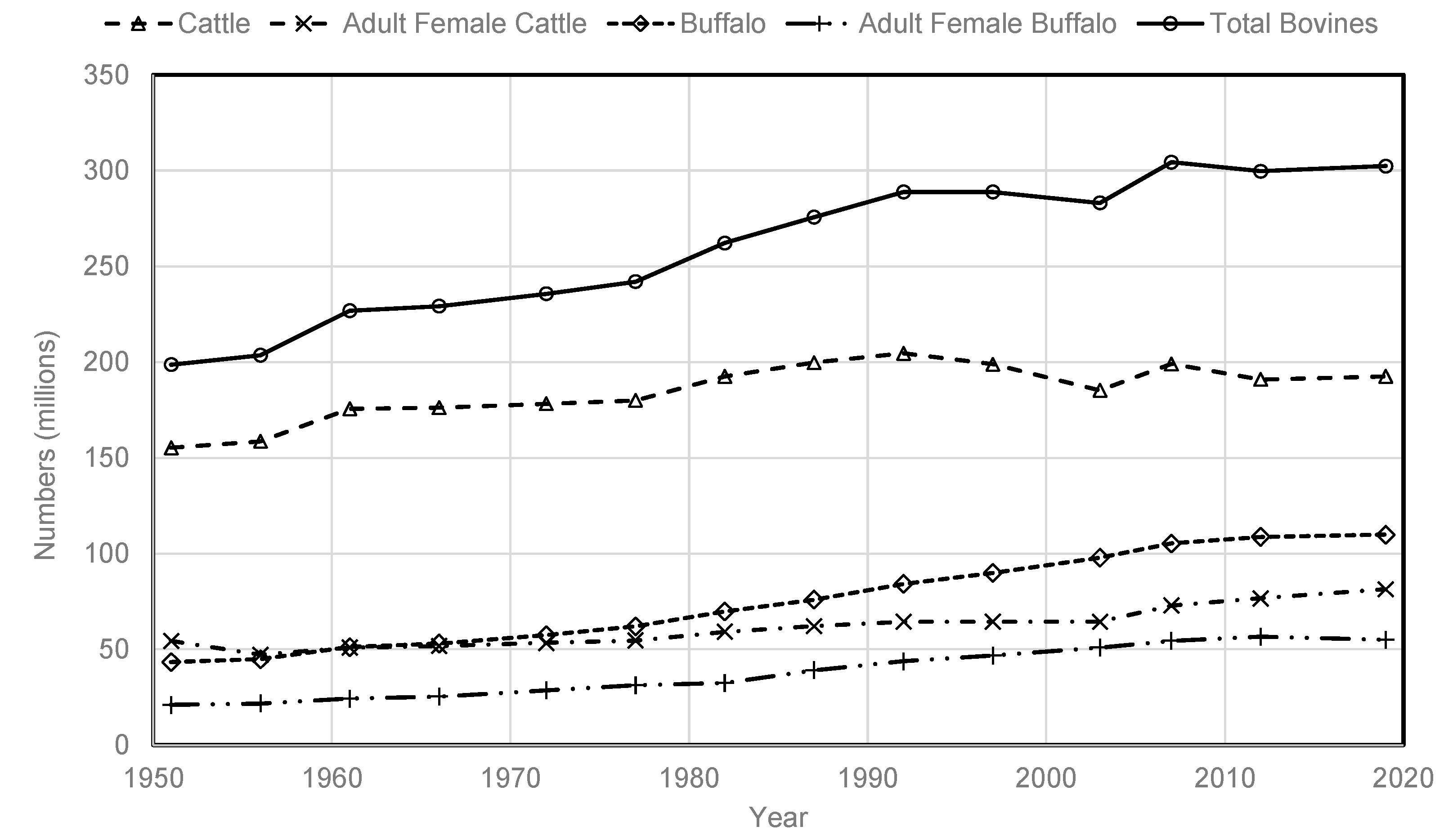
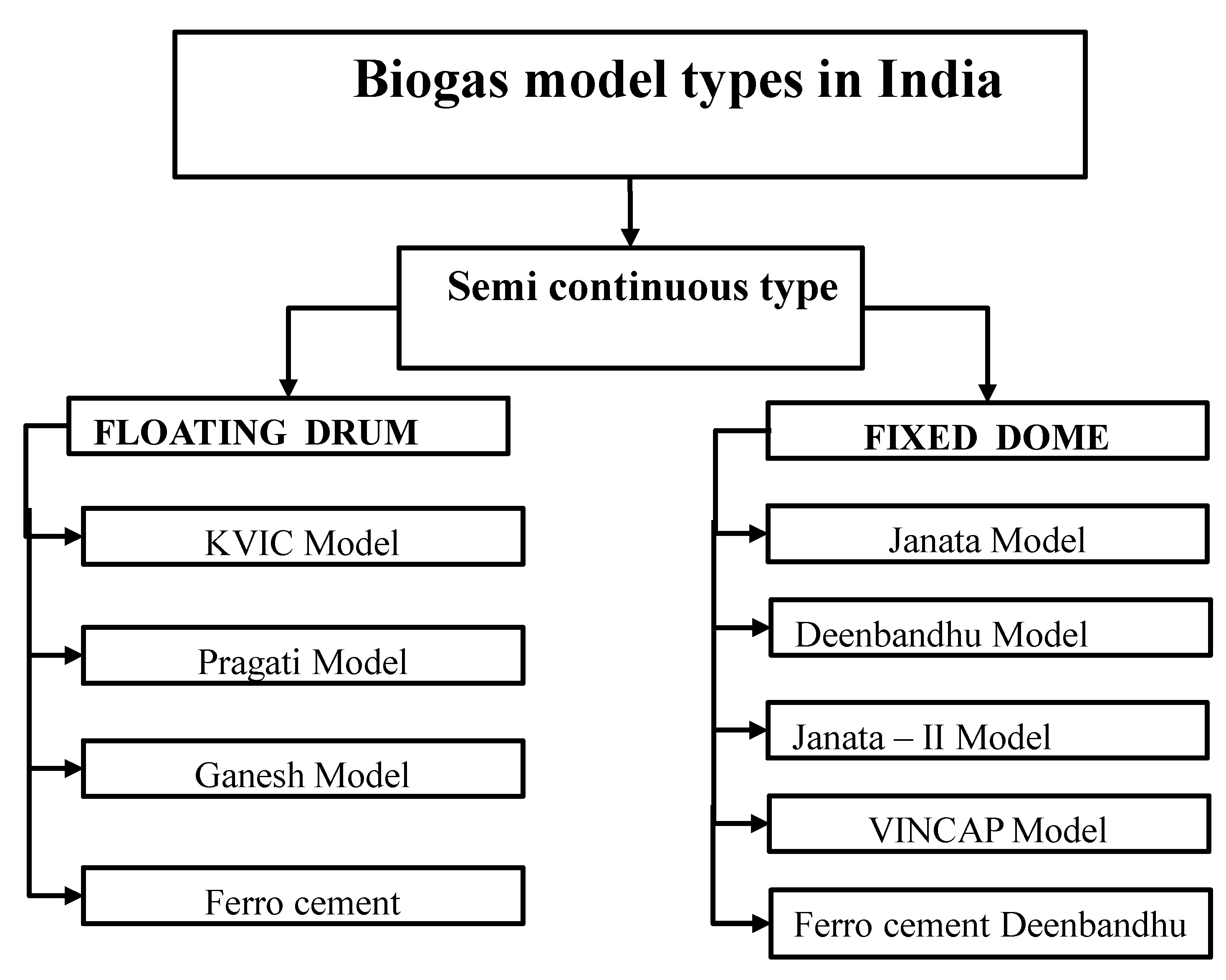
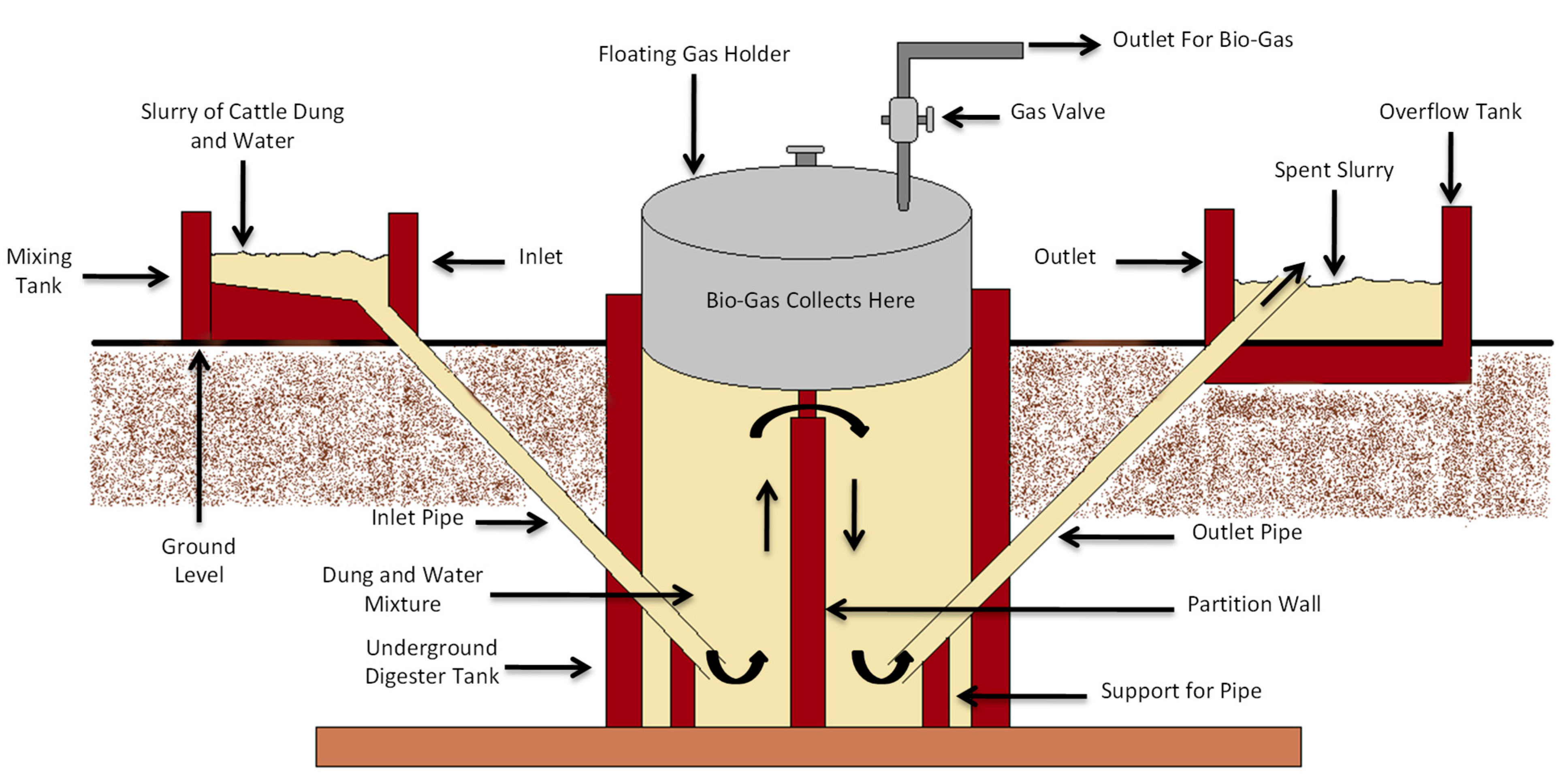
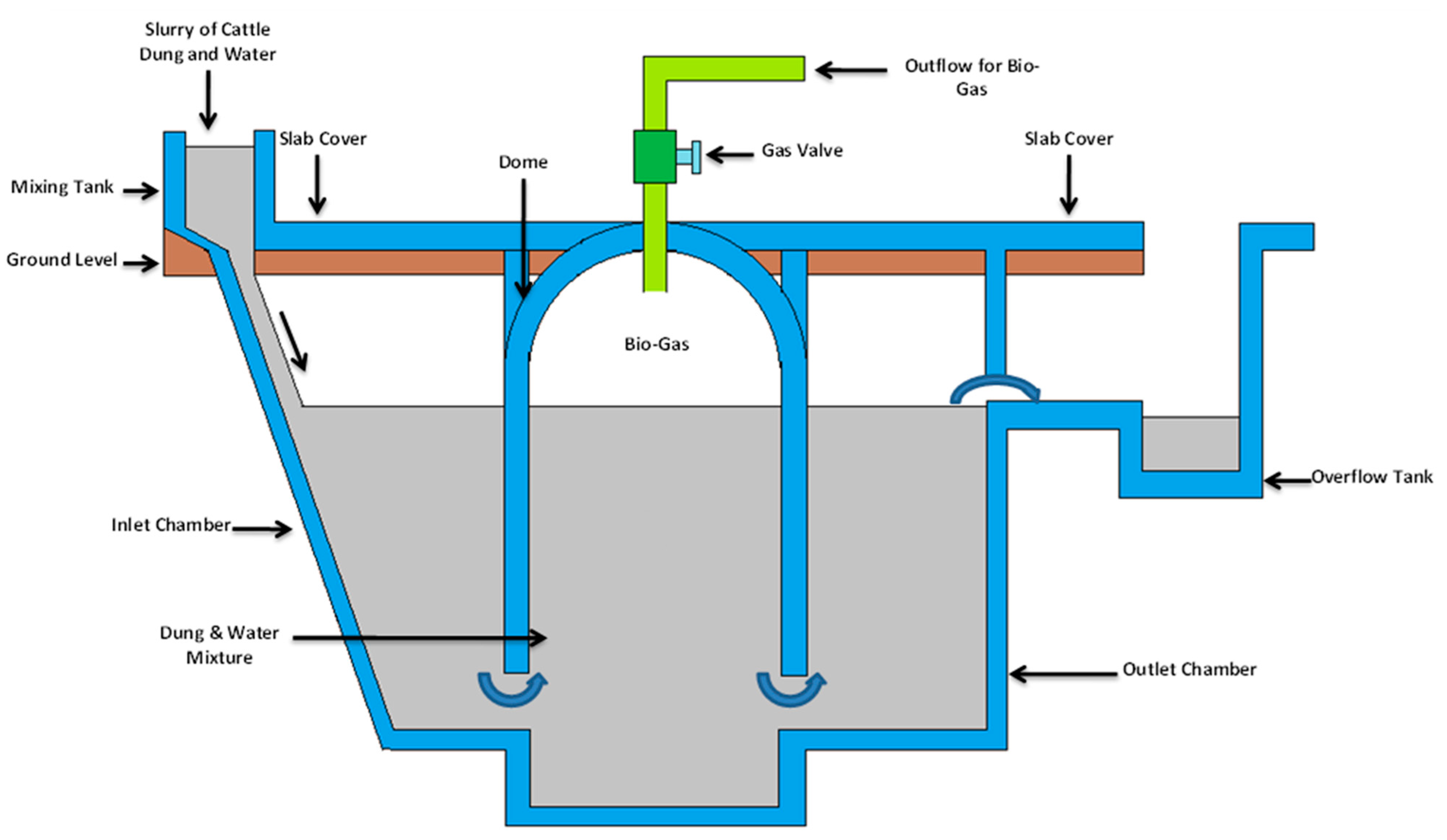
| Animal Type | Numbers (Millions) | Manure (Million kg/Day) | Manure (Tonnes/Year) | Remarks and References |
|---|---|---|---|---|
| Cow | 192.5 | 1405.25 | 730 million | Annual manure production was calculated based on number of animals and manure production per animals. Average cow numbers were obtained from National Dairy Development Board Database [13,14,36]. |
| Buffalo | 109.9 | 802.27 | 574 million | Annual manure production was calculated based on number of animals and manure production per animals. Average cow numbers were obtained from National Dairy Development Board Database [13,14,36]. |
| Poultry | 851.8 | 0.0171–0.0219 | 6.25–8 million | Annual manure production was calculated based on number of animals and manure production per animals. Average cow numbers were obtained from National Dairy Development Board Database [13,14,36]. |
| Sheep | 74.3 | 1.81 | 3.2833 million | Annual manure production was calculated based on number of animals and manure production per animals. Average cow numbers were obtained from National Dairy Development Board Database [14,36]. |
| Goat | 148.9 | 0.625 | 93.0625 million | Annual manure production was calculated based on number of animals and manure production per animals. Average cow numbers were obtained from National Dairy Development Board Database [36]. |
Publisher’s Note: MDPI stays neutral with regard to jurisdictional claims in published maps and institutional affiliations. |
© 2021 by the authors. Licensee MDPI, Basel, Switzerland. This article is an open access article distributed under the terms and conditions of the Creative Commons Attribution (CC BY) license (https://creativecommons.org/licenses/by/4.0/).
Share and Cite
Pandey, P.; Pandey, A.; Yan, L.; Wang, D.; Pandey, V.; Meikap, B.C.; Huo, J.; Zhang, R.; Pandey, P.K. Dairy Waste and Potential of Small-Scale Biogas Digester for Rural Energy in India. Appl. Sci. 2021, 11, 10671. https://doi.org/10.3390/app112210671
Pandey P, Pandey A, Yan L, Wang D, Pandey V, Meikap BC, Huo J, Zhang R, Pandey PK. Dairy Waste and Potential of Small-Scale Biogas Digester for Rural Energy in India. Applied Sciences. 2021; 11(22):10671. https://doi.org/10.3390/app112210671
Chicago/Turabian StylePandey, Prachi, Aditya Pandey, Long Yan, Dengshan Wang, Vinay Pandey, Bhim Charan Meikap, Jiang Huo, Ruihong Zhang, and Pramod K. Pandey. 2021. "Dairy Waste and Potential of Small-Scale Biogas Digester for Rural Energy in India" Applied Sciences 11, no. 22: 10671. https://doi.org/10.3390/app112210671
APA StylePandey, P., Pandey, A., Yan, L., Wang, D., Pandey, V., Meikap, B. C., Huo, J., Zhang, R., & Pandey, P. K. (2021). Dairy Waste and Potential of Small-Scale Biogas Digester for Rural Energy in India. Applied Sciences, 11(22), 10671. https://doi.org/10.3390/app112210671





